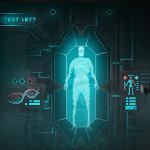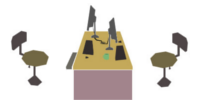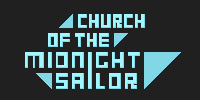Interview: Crying Suns Dev Team
For lovers of innovative pixel art, tactical space combat, and adventures through sci-fi imperialism, Alt Shift flexes impressive muscle, taking influence from Dune/Foundation and FTL with its project Crying Suns, working toward a story-driven experience incorporating battleships and squadron fleets. I spoke with Frédéric Lopez (Art Director) and Julien Cotret (Game Producer and Co-writer) to get their takes on the game’s varied tools and overall aesthetic.
Erik Meyer: You’re creating a tactical rogue-lite in which gamers take the role of a space fleet commander traversing the galaxy, so can you speak to the challenge of combining features like starship combat and exploration with the overall narrative and molding a smooth player experience? Which parts of the project came together first, and as you progress through development, what have you held as your mantra?
Julien Cotret: Our very first idea was to add to the FTL gameplay/formula a sense of scale and a feeling of high stakes. We wanted to focus on macro rather than micro management. We wanted the player to feel that they weren’t just leading a few people on a small ship but a huge battleship with hundreds of crew members trying to save humankind no less! Our first focus was the setup. We toyed for a time with putting the player inside a pirate galleon or a huge mecha, but the scale wasn’t big enough for us. It didn’t feel right. Our first epiphany came when we told ourselves, “Let’s be honest. What we really want is the player to act like Admiral Adama in Battlestar Galactica”. That was it for the setup. Then we iterated over this gameplay idea for about 6 months.
Given the rogue-lite structure of the game, with its inherent constraints, constructing the narrative was a real challenge. We found ourselves facing a lot of questions early on like, how can you write a story that makes sense if the player is constantly dying and starting over again? How does a story like this progress? Or, even, can it progress? Should we focus on a main character? If so, how? And how should the NPCs react if they’ve already seen you, and, in many cases, if they’ve already killed you?
Very early we discovered that these constraints could actually become the story’s strengths, its focal points. We saw that they could actually drive the story as opposed to being something that we would try to avoid or cover up.. So we decided that the player would be the center of a plan to save humankind. And that he would die, often and horrifically, yes, but that he would essentially live on through other clones which would be sent out into our universe over and over trying to save humankind.. Also, regarding the NPCs, we decided, that, unlike in other rogue-lite games, they would actually remember having encountered the player (or having killed the player before). It seemed like a fun, interesting idea to play with, one that was, in a way, a more realistic experience than in other rogue-lites, where, when you run into an NPC, it’s like the first time every time. Altogether, these ideas, we believe, help create a complex yet smooth gamer experience.
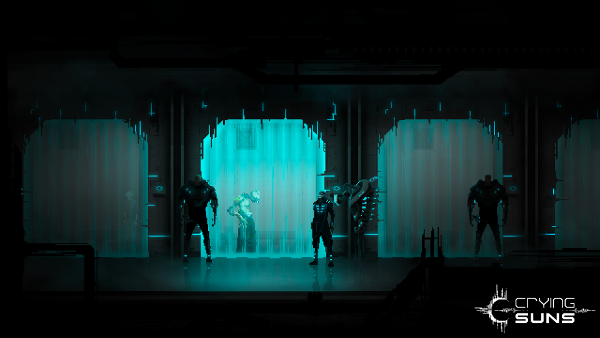
EM: The game mixes pixel art with 3D, so let me into your process a bit; for the spaceships, is it simply a careful skinning process, or do you make use of voxels, etc? Similarly, you’ve drawn back the curtain a bit with Kaliban on Twitter, noting your use of bones and meshes, so what makes a specific asset feel authentic and complete, given the visual aesthetic?
Frédéric Lopez: Indeed, Crying Suns’ look is a mix of different techniques combined to create a unique atmosphere driven by one guiding idea: immersion. So, what makes an asset complete and authentic is mainly its ability to deeply contribute to this desire of immersion, in full consistency with the general aesthetic.
The characters are pure 2D. They are designed in pixel art, then animated with Spine (using bones, paths and meshes) which gives a much smoother and realistic animation quality than traditional pixel-art animation, and a volume effect simulated by mesh deformation of the texture.
The battleships are not made in voxels although it looks a bit like it. Voxels tools were too limited for us to design and manipulate enormous battleships as we wanted. So battleships are designed first in 2D (one side view and several layers in top view) and then extruded to create a 3D model on which we apply a pixel art texture. This technique allowed us to keep a pixelated aspect consistent with the characters and decors while it gave us all the advantages of the 3D (dynamic lightings, real volumes, perspective, etc.). For smaller spaceships, we directly use the 2D textures without extruding them. We simply add a slight parallax effect to simulate depth.
For the User Interface, we mainly use motion design thanks to Lineworks which is a 3rd-party plugin for Unity 3D.
EM: The storyline involves the OMNIs shutting down, resulting in humanity finding itself close to extinction. Looking at narrative and plot, how would you describe your approach to immersion and engagement? What writerly conventions do you find helpful, and to your mind, what gives game events gravity?
JC: Our strategy to immerse and engage the player is a fairly straightforward one: to constantly present him or her with entertaining and/or challenging things to do in an incredibly atmospheric environment. Basically, we want the player to have fun in our world. We’ve tried to do that by creating roughly 400 possible story events (with various possible actions and outcomes in each) that the player can experience on their journey as they travel through star clusters trying to find out who shut down the OMNIs and what can be done, if anything, to save what remains of a damaged humankind. These heavily atmospheric events, which although they depict a world teetering on the brink of annihilation, with people starving, stranded, sick and dying… should be fun.
Early on we also talked about the game having a kind of oral history feel to it. (Possibly because we were reading Please Kill Me: The Uncensored Oral History of Punk at the time). We wanted to give the player the opportunity to basically learn as much about our world, (like, for instance, what life was like in the Galactic Empire when the god-like OMNIs were still functioning) as they wanted. So, like in r.p.g’s, we’ve given the player a chance to ask questions and learn about the history of the empire. Dialogue is important in our story, both in terms of what reveals and its expression.
One particular narrative tool we enjoy using to create an interesting, challenging gameplay is putting Idaho and the player in a situations which are morally difficult, where they must choose to either spare some of the ship’s limited resources to help some suffering people or not. Sometimes you might be rewarded for your altruism. And sometimes, just as in real life, you might not be. Maybe you’ll even be attacked for being kind. And sometimes we’ll throw the player into a situation or event where they’re going to lose no matter what and have to choose between two or three less-than-ideal outcomes. Crying Suns is not a game where you’re going to come out morally righteous or victorious all the time. Sometimes you have to make dirtbag type decisions so that you and your crew can survive. It’s as simple as that. We hope this kind of complex, dark environment sucks the player in. We hope there are other weirdos out there like us.
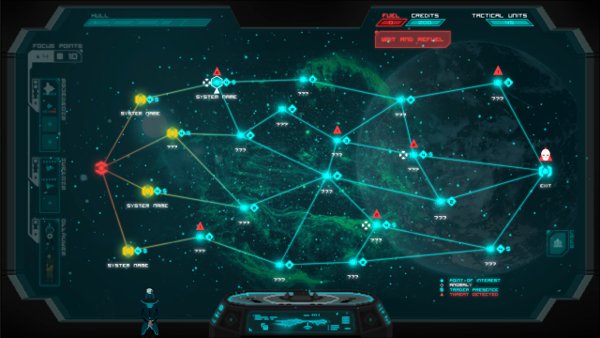
EM: You speak to Foundation and Dune as sources of inspiration, so can you give some examples of the aspects of those universes (either high level concepts or granular minutia) that find their way into your work? Beyond technological or setting differences from the world we live in, what gives the work of Herbert and Asimov its staying power?
JC: We drew two big concepts in our setup from these incredible universes. First, we really liked this idea in Foundation of a galactic empire that has fallen to pieces but has a contingency plan, though one that’s difficult to implement, built in to possibly save it. It’s an interesting setup for a video game because it puts, right from the start, the player in a situation where all the odds are seemingly against him.. It provides a rich atmosphere and gives the main character purpose. Trying to save the universe, the empire, it’s epic, man.
From Dune, we included a more powerful idea, the Spice!… Well, kind of. In our universe, before they mysteriously shut down, the OMNIs were a limited, extremely-valued resource. The rich owned them and the poor worshipped them. Basically, those with the most OMNIs ruled and were the wealthiest. So, as is the case in Dune with the Spice, there is a constant desire from the major players in our world to acquire more OMNIs, no matter the means. And there is a constant effort being made by The Emperor of our story, Oberon, to control how many OMNIs the major players can have and also, because they are extremely powerful, how they can be used.
There are also many smaller ideas in our game inspired by these two great works, (as well as by dozens of other books, movies, comics for that matter.) For example, in our introduction cutscene, in which a clone of Admiral Idaho is awoken by Kaliban on the outskirts of the Galactic Empire, we were thinking a lot about the Axlotl tanks from Dune. But, as it turned out, 100% of our playtesters just told us “Cool, it’s like the Matrix movies. Nice work, guys!”. This helped us acknowledge that, especially in Sci-fi, a lot of important themes are constantly adapted and reworked to match a particular vision.
But apart from these inspirations, we also tried to blend more contemporary themes and personal ideas that we’ve had for a long time, like how common AI’s will be in the future, and how dependent humans will be on them, (we think that they’ll come to do a lot of things for us, perhaps to the point where one day we forget how to do these things ourselves) as well how big corporations will own them, and, of course, how slowly, or not so slowly, their intelligence will surpass our own.
I think that their respective strengths are very different, but I really love these two books now as much as I did when I first read them more than 20 years ago. To me, Dune resonated as a dense multi-layered political thriller and depicted religion in a way that made a lot of sense to me as a teenager: pragmatic and focused on playing an active part in the political game too. However, I’m personally in love with the the fourth book (God Emperor of Dune) which is still, to this day, one of my favorite pieces of Sci-fi. It deals with a very complex subject, the almost omniscience and immortality of Leto II and the burden and loneliness that comes with it. Our own Emperor in Crying Suns, Oberon, shares a lot in common with him.
Foundation is quite different. It’s very “Asimovian”, in a good way. It starts from an interesting idea that is, in my opinion, a timeless concern. Every advanced civilization at some point has crumbled and returned to chaos, but what if we could anticipate it and try to minimize the damage? From there he works his magic with a lot twists and turns that never cease to surprise you.
EM: I’m interested in Alt Shift and your workflow process as a studio; your team has more than a handful of members, so can you walk through an example of the collaboration and communication involved in implementing features within the project? Similarly, when you have to make tough content calls or decide to rescope an asset/feature, who weighs in?
JC: The team has grown a lot during development. At the very beginning, we were only 3 people working on it and it was a collective, iterative effort. Then the team grew slowly to 4 then 5, and now it’s up to 9 people all working exclusively on the game.
Once the vision was clear and shared among the team, we attributed strong responsibilities and roles to different peoples (Artistic Director, Producer, Lead Dev, Lead UX, Lead writer, Lead GD, etc..). Even if you are starting with a common vision and a common goal there are still a lot of choices that need to be made that will not please the whole team. Sometimes it comes down to personal taste and a gut feeling, but you have to make a decision. You also have to keep track of every tiny aspect of your game, and as the complexity grows, it’s nearly impossible for one person to know 100% of what’s going on with each aspect. So you give these responsibilities to different leads.
To us, it’s very important to maintain a working balance of power between the different leads so that everyone can focus on his or her mission with as few burdens and biases as possible. We use an agile in-house adaptation for our development process so we have frequent occasions to share our knowledge, opinions and to talk about the current state of the game so as to avoid losing sight of the big picture. Once the game reached a level where it was playable, we’ve also tried to deliver a new version of the game every 10 business days so that it could be sent to playtesters to provide the quickest feedback loop possible.
As for who makes the tough, final choices, well, it’s mostly the producer’s responsibility. His job is to make sure the project is on track and that we don’t have any blind spots. If it’s not, then he has to gather the right leads to discuss the issue until they can find a workable solution that puts the project back on track without damaging what’s vital to the game.
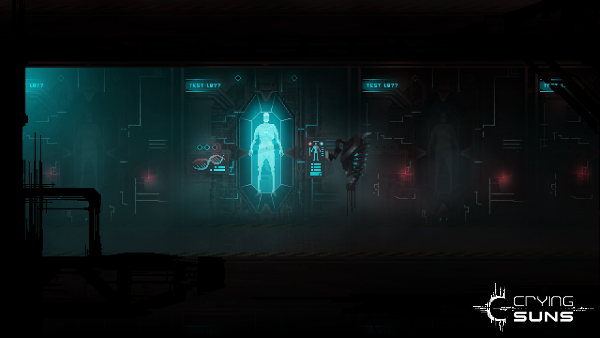
EM: Via social media, you’ve shown the animation of your in-game UI, so when it comes to interactive elements, what is your design philosophy? Do you follow a more utilitarian mindset, or do you see the UI’s art and style contributing to the game experience in a way that makes it as essential as the spaceships or NPCs?
FL: Well, in the beginning, we basically felt like there were two approaches to the UI that we could use. One was, yes, a more utilitarian, simplistic approach, a UI that was much simpler to create and hopefully functional. The other was an approach that was maybe more organic in process, where you try to make an interface deeply integrated with your game. Something that’s more complicated and nuanced.
We started with the first approach, to test as soon as we could, which was a mistake. We started with something that was simple and, more or less, hoped it would match all of our needs in the game play. It didn’t. And we quickly discovered that. And, more to the point, this interface created a game experience that we did not want for the player. We realised that UI was way more than just the buttons and the size of windows. It was a huge part of the game.
So, we basically went back to the drawing board, and, though it was a lot of work, and a lot of back and forth between UI design, Game Design, Art, we created an interface that was more, uh, in harmony with the game, that felt part of the game, more natural and intuitive for the user. Basically, it was user-friendly, felt better, and was fun, and reflected our goals for the game.
EM: One thing I get from following your gifs on Twitter is a strong sense of sarcasm and silliness in the interactions, albeit a kind of dark, morbid humor. When you look at the project’s overall feel, what kind of impact do you see quirky or eccentric characters having on the experience, and how do you balance the overall message/experience?
JC: Most of our universe has a very dark tone as humankind and the Galactic Empire is on the verge of extinction. Famine, disease, infertility, violent climate change, cannibalism, you name it, all the worst stuff possible is happening in our game. Ha. As these elements are super heavy, we felt that it was possibly a good idea to periodically relieve the tension and even the potential monotony of inhabiting a world like this. Also, people make jokes even in the worst of situations, like, you know, when certain reality TV stars become president. It’s a coping mechanism. It’s natural. Lastly, you know, who doesn’t like to make jokes and laugh? Humor is important to us. So, yes, there is a dark sense of humor running throughout the game. It’s especially evident in Kaliban, our weird, maybe even slightly perverted, robot.
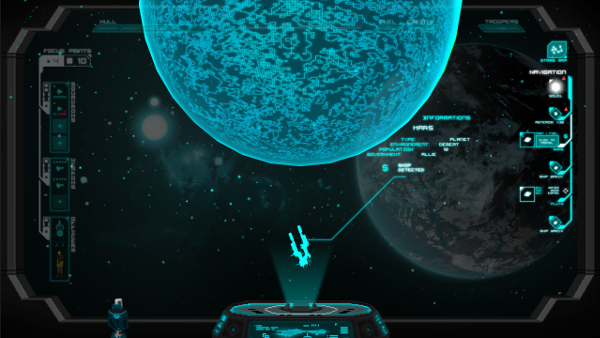
EM: During the genesis of most projects, an ‘aha moment’ presents developers with novel ideas or key insights driving the effort forward, so for your team, what have been critical lessons learned or inspiration events?
JC: I think that the most important trigger we had was when we understood what we wanted the player to feel like. At some point in the early development, as I stated in another question, we just knew exactly what our goal was. We realised we wanted to make a game where you are the admiral and you give orders and you know that each order could lead your men and women to their death and possibly to your own. It was a departure from a more hero-centric view. You’ll never be at the center of the action. You’ll always have to delegate. But at the end of the day you’re the one responsible for everything, success or failure, life or death. That was the feeling we knew we wanted to build on.
As for a critical lesson, there have been so many. But maybe the most interesting one we’ve learned is the amount of writing required for a complex, rich story like this. At the beginning, we really thought that we would be able to finish writing long before the end of the game development. This wasn’t the case. Creating a complex yet coherent universe, even when drawing from inspirations, is an incredible amount of work. I think that we must have over 800 pages of material for the game!

